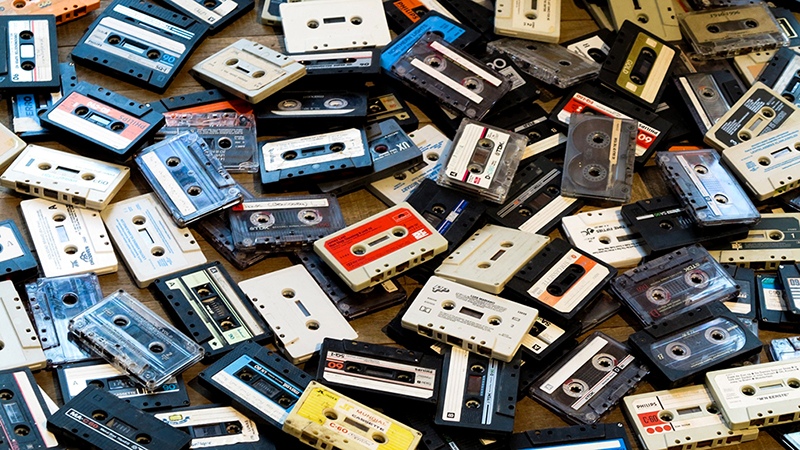Technodecadents as a product of copyright beneficiaries: not only vinyl has resurrected, compact cassettes are next

But after they came for me the unexpected happened, in Britain they bought a lot of cassettes again, not just a lot … more than 65,000 cassettes … in half a year. Not 65, not 650, not 6500 – sixty-five thousand. And that’s only in Britain! Then I realized that the beautiful Britain of the future is crazy – while the nation is eating its last porridge without salt in anticipation of the coronavirus stagnation, someone bought a record number of compact cassettes over the past 15 years, and by the end of the year the figure is predicted to be 100,000.
The previous record was set in the past 2019 (about 60,000 cassettes were bought in the UK over the year). According to the BBC, at the moment the figures are approximately twice as high as last year for the same period. Under the cut, we are talking about what the paradoxical growth of cassette sales of a seemingly obsolete format is connected with, and how copyright is connected with it.
Cassette tapes and sound quality
I suppose we will immediately discard the version about higher fidelity of reproduction from cassettes. Without going into details, one can identify the main problems of analog audio reproduced from compact cassettes, these are:
- limited frequency range;
- detonation;
- nonlinear distortions arising at various stages of the path.
Thus, “Good Sound” is not the cause of the cassette renaissance, nor is the vinyl renaissance that preceded it. There is also a certain phenomenon of “analog sound”, which is perceived by many people as more “pleasant”, “lively”, “high quality”.

We will not consider this phenomenon either. The fact is that in blind tests, people claiming the ability to accurately identify “analog sound” were not able to differentiate between recordings played directly from analog media and digital copies from these analog media (mp3 copies with a bitrate of 320 kb / s) , for example, vinyls, with a characteristic crackling and detonation.
Cassettes and copyright
I am inclined to believe that in addition to the attractive ritualization of the process, which I wrote about here, the position of large copyright holders may become the cause of the cassette renaissance. Vinyl has one significant drawback that limits its use. It is stationary, it is almost impossible to use it portable.
During the heyday of the compact cassette, it was a direct competitor to the record, mainly due to the fact that it allowed the production of an almost unlimited number of analog copies. Tape recorders were relatively inexpensive, and their development did not require special knowledge. It was in connection with the spread of compacts that the problem of mass audio piracy arose. Today, cassette recorders are relatively rare; they can only be purchased at flea markets. The cassettes themselves are also rare, there are only a few online stores that sell them.
Moreover, the new generation is not very well aware of how to use equipment for recording cassettes, and even if they figure it out, they are unlikely to use it. Cassettes are converted into collectible value, a thing in itself, subject to their licensed publication. Similar processes took place in the wake of the vinyl renaissance.
I suppose that at first the cassettes will be positioned as something rare and elite, releasing small editions that will be less than the expected demand. Then the created deficit will begin to be fertilized with publications of the relevant media and hidden advertising in films that will demonstrate that cassettes are fashionable and cool. Thus, a fairly decent niche demand will be formed. Not thousands, but millions of copies. To support it, consumers will be offered a kind of listening culture.
No conspiracy, just business
Why am I inclined to consider the cassette renaissance, if not a project of large copyright holders, then a process that received support or was initiated by them? Everything is simple, it is enough to correlate several facts and try to understand who is their beneficiary.
So the facts. The biggest cassette sales in the UK in recent years are 5 Seconds of Summer and Lady Gaga. Each of these artists has sold about 12,000 cassettes in Britain alone, according to What Hi-Fi. What was previously considered impossible due to the death of the format. Moreover, Lady Gaga’s album took only two months for such an impressive result (data for the beginning of July 2020).
The publisher of the aforementioned record holder is Sony / ATV Music Publishing, which in turn are part of one of the world’s largest copyright holders, Sony Entertainment. Thus, one transnational conglomerate Sony Corporation is the publisher of the best-selling cassette albums. The publishing divisions of which are known for trying to arrogate to themselves the copyright on anything, and are known for the most draconian strikes on the same Youtube.
Let’s take another musician who has been relatively successful on cassette in the recent past. Billie Eilish sold 4,000 copies of When We All Fall Asleep, “Where Do We Go?” on cassettes in just 5 months. He also previously collaborated with Sony / ATV Music Publishing, but they have nothing to do with the release of this album. But it has another largest copyright holder of music in the world – Universal Music Group, which owns the label Interscope Records that released the album.
Universal Music Group, as well as Sony Entertainment, are interested in as many ways as possible to profit from copyright. Moreover, it solves the problem of portable playback that is not available on vinyl. It seems natural that publishers protect their financial interests, including in such an unusual way as digging up and repopulating an archaic format for those who want to be given nostalgic memories or join the triumphant past of a forgotten format. This does not seem to me to be a very fierce conspiracy thesis, although I certainly could be wrong. One way or another, the popularity of old formats, with all their shortcomings, is beneficial to publishers and copyright holders.
Ahead
I’ll try to speculate about the future of the magnetic phoenix. For a while, cassettes will be a niche history, and their sales against the background of online music sales and streaming will not be noticeable from the word at all, even if they begin to grow exponentially. Meanwhile, the dynamics of growth is obvious and it is quite possible that with sufficient efforts to promote the idea of fashionable cassettes and tape recorders, in ten years we will become witnesses of what is happening with vinyl today. Maybe Sony will even restart the cassette Walkman. I am convinced that the main motivation for resurrecting archaic media is to profit from the added value created by the efforts of marketing and the introduction of stereotypes that publishers need. I would be grateful for your views on the topic in the comments.
Advertising
we we sell electronics, in our catalog many different things, no audio tapes yet. But it is possible that they will appear in the future.





